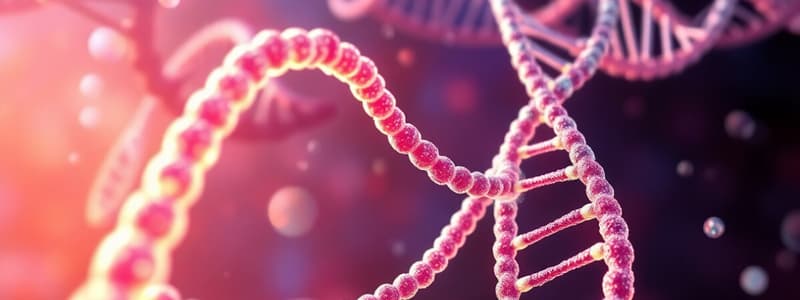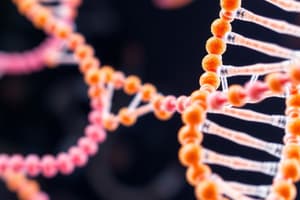Podcast
Questions and Answers
Which of the following nitrogenous bases is found in RNA but not in DNA?
Which of the following nitrogenous bases is found in RNA but not in DNA?
- Uracil (correct)
- Guanine
- Thymine
- Adenine
DNA is a single-stranded molecule.
DNA is a single-stranded molecule.
False (B)
What are the two main types of nucleic acids?
What are the two main types of nucleic acids?
DNA and RNA
The primary structure of nucleic acids refers to the linear sequence of ___________.
The primary structure of nucleic acids refers to the linear sequence of ___________.
Match the following types of RNA with their functions:
Match the following types of RNA with their functions:
Where is most of the DNA located in a eukaryotic cell?
Where is most of the DNA located in a eukaryotic cell?
The pentose sugar found in RNA is deoxyribose.
The pentose sugar found in RNA is deoxyribose.
What type of bond links nucleotides together to form the backbone of a nucleic acid?
What type of bond links nucleotides together to form the backbone of a nucleic acid?
DNA is typically single-stranded, while RNA is double-stranded.
DNA is typically single-stranded, while RNA is double-stranded.
The process of breaking down cells to release nucleic acids is called ______.
The process of breaking down cells to release nucleic acids is called ______.
Which type of RNA carries the genetic code from DNA to ribosomes?
Which type of RNA carries the genetic code from DNA to ribosomes?
Match the following nucleic acid types with their primary functions.
Match the following nucleic acid types with their primary functions.
What is the primary function of genomic DNA?
What is the primary function of genomic DNA?
Which of the following techniques is used to separate DNA or RNA fragments based on size?
Which of the following techniques is used to separate DNA or RNA fragments based on size?
The ideal A260/A280 ratio for pure DNA is approximately 2.0.
The ideal A260/A280 ratio for pure DNA is approximately 2.0.
Flashcards
Nucleic Acids
Nucleic Acids
Complex biomolecules that store and transmit genetic information.
DNA
DNA
Deoxyribonucleic Acid, double-stranded, contains genetic blueprint.
RNA
RNA
Ribonucleic Acid, usually single-stranded, involved in protein synthesis.
Nucleotide
Nucleotide
Signup and view all the flashcards
Nitrogenous Base
Nitrogenous Base
Signup and view all the flashcards
Deoxyribose
Deoxyribose
Signup and view all the flashcards
Phosphate Group
Phosphate Group
Signup and view all the flashcards
Primary Structure of Nucleic Acids
Primary Structure of Nucleic Acids
Signup and view all the flashcards
RNA Structure
RNA Structure
Signup and view all the flashcards
Tertiary Structure
Tertiary Structure
Signup and view all the flashcards
DNA Function
DNA Function
Signup and view all the flashcards
Types of RNA
Types of RNA
Signup and view all the flashcards
Cell Lysis
Cell Lysis
Signup and view all the flashcards
Spectrophotometric Analysis
Spectrophotometric Analysis
Signup and view all the flashcards
Gel Electrophoresis
Gel Electrophoresis
Signup and view all the flashcards
Study Notes
Nucleic Acids: Definitions
- Nucleic acids are complex organic molecules that store and transmit genetic information, crucial for protein synthesis.
- Composed of long chains of nucleotides, each containing a nitrogenous base, a pentose sugar, and a phosphate group.
- Two main types: DNA and RNA.
Types of Nucleic Acids
DNA (Deoxyribonucleic Acid)
- Double-stranded molecule, forming a double helix.
- Contains the genetic blueprint of an organism, primarily located in the nucleus of eukaryotic cells, and in mitochondria and chloroplasts.
- Its structure allows for accurate replication, preserving genetic information.
RNA (Ribonucleic Acid)
- Typically single-stranded, but can fold into complex shapes.
- Plays roles in gene expression, particularly in protein synthesis.
- Different types include:
- mRNA (messenger RNA): Carries genetic code from DNA to ribosomes.
- tRNA (transfer RNA): Delivers amino acids to ribosomes for protein assembly.
- rRNA (ribosomal RNA): Combines with proteins to form ribosomes.
- snRNA (small nuclear RNA): Involved in mRNA splicing and regulatory processes.
Occurrence of Nucleic Acids
- Present in all living cells and viruses.
- Essential for storage and transmission of genetic information and protein synthesis.
- Two primary types: DNA and RNA.
Structure of Nucleic Acids
- Nucleic acids are polymers of nucleotides.
- Each nucleotide contains:
- A nitrogenous base (purine or pyrimidine).
- A pentose sugar (deoxyribose in DNA, ribose in RNA).
- A phosphate group.
- Nucleotides are linked by phosphodiester bonds, forming the nucleic acid backbone.
- DNA has a double-helix secondary structure stabilized by hydrogen bonds between complementary base pairs (A-T and G-C).
- RNA is typically single-stranded but can form secondary structures like hairpin loops.
- Tertiary structures are more complex folds in both DNA and RNA, influenced by functions like enzymatic activity (ribozymes).
Isolation of Nucleic Acids
- Methods include:
- Cell lysis to release nucleic acids.
- Removal of proteins using proteases or extraction techniques.
- Precipitation of nucleic acids using ethanol or isopropanol.
- Purification by separating DNA from RNA using specific reagents.
Characterization of Nucleic Acids
- Methods include:
- Spectrophotometry to measure absorbance (quantify and check purity).
- Gel electrophoresis to separate nucleic acids based on size.
- PCR to amplify specific DNA sequences.
- Sequencing to determine nucleotide sequences.
- Hybridization techniques (Northern, Southern, In Situ) to detect specific nucleic acid sequences.
- Enzyme digestion (using restriction enzymes, RNases, and DNases) to analyze DNA fragments and study stability.
Methods for Isolation
- Phenol-chloroform extraction.
- Silica-based column methods
- Density gradient centrifugation.
Studying That Suits You
Use AI to generate personalized quizzes and flashcards to suit your learning preferences.




